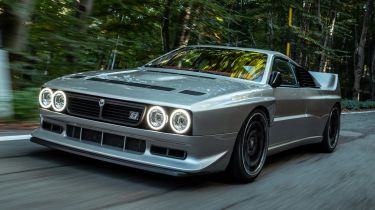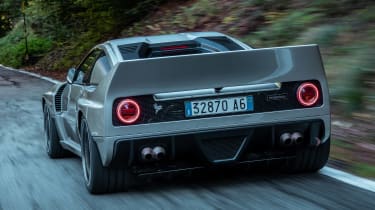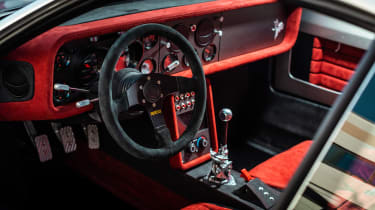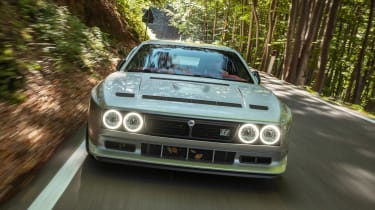Kimera EVO37 review: Lancia 037 restomod on the road
Former rally driver Luca Betti inherited a love of Lancia from his father, and he’s poured all that passion into a recreation of one of the company’s most famous rally stars, the 037
Luca Betti grew up with motorsport and a great love for Lancia, passed on from a father who won the Italian Rally Championship in 1980 at the wheel of the iconic Stratos. Apples don’t fall far from the tree, and Luca has driven more than 150 rallies all over Europe with Fiat, Renault, Peugeot and Honda, and in 2011 he finished as runner-up in the European Rally Championship.
We meet him at Villa Kimera near Turin, a 17th-century property named after the mythical winged lion with the horns of a ram, and a snake for a tail, which also serves as HQ for Betti’s company, Kimera Automobili. That’s the name of the outfit responsible for one of the most eye-catching of the new breed of restomods, the Kimera EVO37, which is inspired by the epic Lancia 037 rally cars that graced rally stages in the early eighties.
Few would argue that the resurrection of the legendary Lancia 037 is anything other than an excellent choice; the car is not only a thing of beauty, but also an extremely successful one from a time when Lancia was a powerful competitor in international rallying with, among others, the Fulvia, the Stratos, the Delta S4 and the Integrale.
The 037 was such a competent Group B machine that in the 1983 season it even managed to snatch the manufacturers’ world rally title away from the all-powerful Audi Quattro, despite it only being rear-wheel drive. In total, just over 200 Lancia 037s Stradales were built, enough to meet homologation requirements.
Betti refers to his Kimera as a restomod, but with that he’s really selling the car short, because the car has been redesigned from head to tail; only two parts are exactly the same as on the original 037.
Lancia took the cockpit of the Lancia Montecarlo and provided it with subframes at the front and rear to attach the suspension to. Betti also uses the cockpit of the Montecarlo, but only as a “cladding” for the newly developed tubular chassis of his EVO37. The Kimera is therefore considerably stiffer than the original Lancia. Another advantage is that the driver and passenger in the modern car are safe in the knowledge that they are surrounded by a strong roll cage.
The second part of the Montecarlo that Lancia used for the 037 was the engine. That example has also been followed by Betti and his team, but the performance of the time has been pushed to considerably greater heights. The Kimera’s engine is assisted by a Volumex supercharger, just like in the original 037. However, as with the Delta S4, it is also helped by a large water-cooled turbocharger. The supercharger does not continuously rotate with the crankshaft, but is turned on and off by an electrical clutch in the drive pulley.
Because the supercharger provides boost from low revs, Kimera has also been able to add a large Garrett turbocharger without having to worry about EVO37 drivers experiencing lag; as soon as the turbo is up to speed, the supercharger takes a short break. Naturally, all moving parts of the engine have been upgraded to withstand the forces, and the block has been reinforced at the base with a special strengthening plate.
The production models will offer around 420bhp, but EVO37 owners will be able to activate Race mode with what Betti calls “a small ceremony”, giving them no less than 505bhp on tap.
We can vouch for the claim that on its way to 7,000rpm this engine makes the Kimera EVO37 accelerate with as much explosive force as a Ferrari F40. However, that shouldn’t come as a surprise when you realise the new car’s power-to-weight ratio is almost equal to that of the legendary Ferrari supercar.
The sensations are made stronger by the hissing and whistling of the turbo and wastegate, and the typical whine of the supercharger. You hear one take over from the other every time you move the accelerator, and the exhaust note is so loud that, when it’s angry, the Kimera can be heard from several hundred yards away.
The way with which the four-cylinder engine reacts to the throttle is immediate; the supercharger and turbo work together so well. You can calm the storm building behind your back somewhat by shifting up a gear early – but even then the torque can still surprise you.
There’s a volcanic 600Nm of torque ready to erupt at any moment, with more than enough force to spin the Pirelli tyres into submission. We’re sitting in the driving seat of a pre-production car, but customers of the finished EVO37 will have the luxury of traction control, albeit a set-up calibrated for racing cars.
The Kimera is a pure two-seater, with space for a little luggage in the nose. You sit on hard, wafer-thin bucket seats with five-point belts, and the seating position is old-fashioned Italian, with legs spread. The decoration of the interior radiates craftsmanship, with beautiful materials like carbon fibre and Alcantara, and everything appears well made. We’re looking at a battery of clocks; well, their dials, because none of them work in the prototype; the instruments for the production cars have yet to be delivered. In finished versions, passengers will have the fascinating pleasure of looking at the pressure gauges of the turbocharger and supercharger, and seeing how they work together from the dancing of the needles.
They can also count on an air-conditioning system – this car certainly gets hot inside – and a simple entertainment set-up with satellite navigation. Plus, given that the EVO37 isn’t equipped with a rear-view mirror because of the large spoiler that blocks the view, it’s also fitted with a rear-facing camera. The wing mirrors will also be larger than the minuscule examples fitted to the prototype.
The main power switch and the fuel-pump switch are located in the centre console. To activate the starter motor you have to simultaneously press two tiny buttons, left and right of the tunnel through which cables run to the Graziano six-speed gearbox. The gearchange mechanism is a jewel, the gearstick is exactly where your hand expects it to be, and it moves through the gate with nice, dry clicks. An automatic dual-clutch transmission will also be available, but so far no buyer has asked for it.
Once we’re settled into the Kimera, we soon escape the hustle and bustle around Turin and get out into the hills. The sprint to the top is a rather noisy one, mainly because the prototype does not yet have the butterfly valves in its exhaust system that can be used to mute production Kimeras. Luca doesn’t intend to make his Kimera too quiet, though; the sounds of the supercharger and turbocharger are music to the ears of an enthusiast. You will always be, as Luca says, “in the middle of the machine”.
The pace is also good on the descent, but it can be even faster, according to Luca, who urges me to take yet more speed into the corners. Given that he’s an international-class rally driver, I follow his instructions, and indeed, even when I neglect the brakes, the Kimera dives into the apexes without a slip.
The steering is incredibly direct and fast, and there are few situations where you have to change the position of your hands on the wheel. The car rotates beautifully around its central axis; it’s the kind of set-up that rally drivers like Luca and his friend and helper Niki Biasion (two-time world rally champion with Lancia) truly appreciate.
The EVO37 maintains contact with the road through forged double-wishbone suspension, and the movement of the springs is controlled by Ohlins dampers, two per rear wheel. Although the wheels read the road surface with almost seismographic precision, the suspension and damping are quite hard, but there is enough absorbency to not have to worry about longer journeys.
Front and rear, the car has ventilated disc brakes of equal size with four pistons per caliper, sourced from Brembo. When you press the brake pedal, you’re immediately greeted with more than hefty deceleration, rather as if you’d deployed a parachute. Exactly as you’d want, the EVO37 brakes confidently, not only hard, but also dead straight, and the nose barely dives. The steering is also a constant pleasure, light and precise, and communication with the chassis is so good that the Kimera is reminiscent of a Lotus. Think of an Exige with the performance of the Ferrari F40, and you have a good idea of where the EVO37 sits in the spectrum of super-sportscars.
What does a Kimera EVO37 cost? Count on 480,000 Euros (£410,500). That’s in line with the price of a Singer 911, but only around half of what you have to put on the table for one of the 200 or so original Lancia 037 Stradales. The strength of Betti’s Kimera is that it retains the character and personality of the original car, with a modern twist. The 037 could have been as the EVO37 is now if Lancia had developed it. The beauty, the speed, the style, everything that made the original so desirable is there, in at least the same quantities, but often to an even greater degree.
As Luca himself readily admits, he has done everything to preserve the soul of the original 037 in his car. Those words echo for a moment in my ears as he drifts the Kimera around a hairpin bend – with a gloriously roaring engine, angrily whining supercharger, and screeching tyres – every bit as perfectly as the legendary Walther Röhrl and Marku Alèn did with the 037 in the early eighties. You don’t have to worry about the soul of the original; it’s definitely there, loud, clear and pleasing to the eye.
Luca hopes to sell 37 EVO37s, and at the time of our visit 21 had been ordered by customers all around the world, including one in the UK. The first production car, in metallic green with bronze-coloured wheels and yellow headlights, will be delivered by Kimera Automobili soon, but if you also fancy putting one on your driveway, we have to warn you, the waiting list is up to 18 months already…
| Model: | Kimera EVO37 |
| Engine: | Four-cylinder 16-valve, two overhead camshafts, bore/stroke 85/95 mm, capacity 2,150cc, Garrett turbocharger and Volumex supercharger with air/water intercooler, dry sump lubrication |
| Power: | 505bhp at 7,000–7,250rpm |
| Torque: | 600Nm maximum, 400Nm at 2,000rpm |
| Transmission: | Rear-wheel drive, limited-slip differential, Graziano six-speed manual gearbox |
| Tyres: | Front 245/35 R18, rear 295/30 R19 |
| Brakes: | All-round 365mm ventilated discs with four pistons per caliper |
| Dimensions: | 4,055/1,905/1,200mm (L/W/H), wheelbase 2,520mm, Cd 0.50 |
| Weight: | Approximately 1,000kg |
| Price: | 480,000 Euros (£410,500) |
Find a car with the experts







